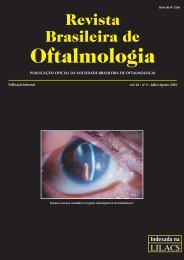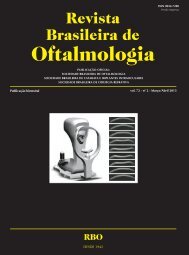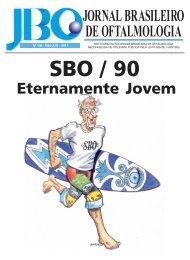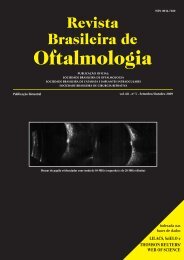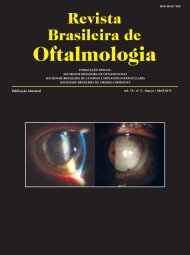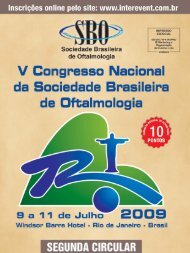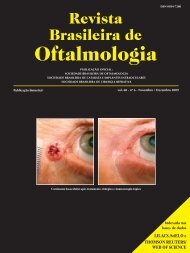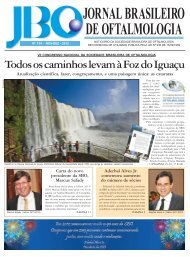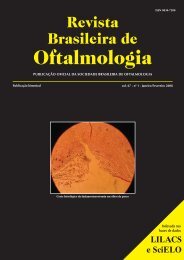Jan-Fev - Sociedade Brasileira de Oftalmologia
Jan-Fev - Sociedade Brasileira de Oftalmologia
Jan-Fev - Sociedade Brasileira de Oftalmologia
- No tags were found...
Create successful ePaper yourself
Turn your PDF publications into a flip-book with our unique Google optimized e-Paper software.
50<br />
Monteiro MLR, Hokazone K<br />
Figure 1: Case 1 - Goldmann visual fields showing complete left homonymous hemianopia. Middle, fundus photograph showing diffuse pallor<br />
in the right eye (OD) and band atrophy of the optic nerve in the left (OS). Below, Stratus - Optical coherence tomography showing retinal<br />
nerve fiber layer loss in the superior and inferior quadrant (arrows) in OD and in the temporal and nasal aspects of the optic nerve in OS<br />
(arrowheads)<br />
of the disc, with relative preservation of the superior and<br />
inferior quadrants in the eye with temporal hemianopia.<br />
Such findings are in agreement with Mi<strong>de</strong>lberg and<br />
Yi<strong>de</strong>giligne’s (10)<br />
histological analysis of a patient with<br />
band atrophy and seems to confirm previous studies in<br />
patients with chiasmal compression and BA of the optic<br />
nerve (4-6, 11) . However, our patient also serves to<br />
<strong>de</strong>monstrate the pattern of RNFL loss in the eye with the<br />
nasal hemianopia which has been the subject of only one<br />
previous publication (9) . In both eyes with the nasal<br />
hemianopia Stratus-OCT disclosed RNFL loss in the superior<br />
and inferior quadrants, documented loss of fibers<br />
originating from the temporal retina that enter the optic<br />
disc through the superior and inferior arcuate bundle<br />
fibers.<br />
Our cases are interesting because confirm that<br />
OCT may be of help when investigating patients with<br />
homonymous hemianopia, since the associated<br />
occurrence of RNFL loss indicates the possibility of either<br />
and optic tract or a geniculate body lesion (12) and rule out<br />
the possibility of optic radiation or occipital lobe diseases.<br />
Although clinical findings of optic disc pallor and a<br />
relative afferent pupillary <strong>de</strong>fect in the eye with the temporal<br />
hemianopia can directly indicate the diagnosis of<br />
an optic tract lesion, the use of OCT may be of help when<br />
clinical findings are doubtful or difficult to obtain. While<br />
a good clinical evaluation of RNFL thickness has long<br />
been documented to be of importance in the diagnosis of<br />
optic tract lesion, the current findings are important to<br />
confirm the possible use of Stratus-OCT for quantifying<br />
Rev Bras Oftalmol. 2008; 68 (1): 48-52



